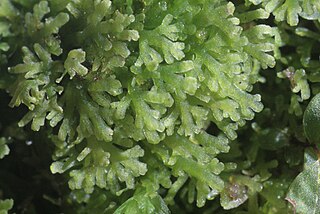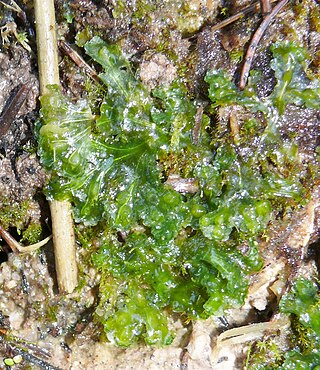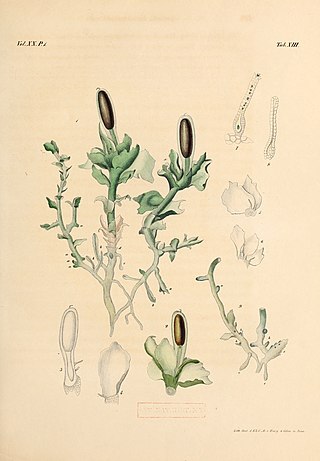
The Celastrales are an order of flowering plants found throughout the tropics and subtropics, with only a few species extending far into the temperate regions. The 1200 to 1350 species are in about 100 genera. All but seven of these genera are in the large family Celastraceae. Until recently, the composition of the order and its division into families varied greatly from one author to another.

The Marchantiophyta are a division of non-vascular land plants commonly referred to as hepatics or liverworts. Like mosses and hornworts, they have a gametophyte-dominant life cycle, in which cells of the plant carry only a single set of genetic information.

Hornworts are a group of non-vascular Embryophytes constituting the division Anthocerotophyta. The common name refers to the elongated horn-like structure, which is the sporophyte. As in mosses and liverworts, hornworts have a gametophyte-dominant life cycle, in which cells of the plant carry only a single set of genetic information; the flattened, green plant body of a hornwort is the gametophyte stage of the plant.

Paulowniaceae are a family of flowering plants within the Lamiales. They are a monophyletic and monogeneric family of trees with currently 7 confirmed species. They were formerly placed within Scrophulariaceae sensu lato, or as a segregate of the Bignoniaceae.

Metzgeriales is an order of liverworts. The group is sometimes called the simple thalloid liverworts: "thalloid" because the members lack structures resembling stems or leaves, and "simple" because their tissues are thin and relatively undifferentiated. All species in the order have a small gametophyte stage and a smaller, relatively short-lived, spore-bearing stage. Although these plants are almost entirely restricted to regions with high humidity or readily available moisture, the group as a whole is widely distributed, and occurs on every continent except Antarctica.

Cavicularia densa is the only species in the liverwort genus Cavicularia. The species was first described in 1897 by Franz Stephani, and is endemic to Japan, where it grows on fine moist soil.

Blasiaceae is a family of liverworts with only two species: Blasia pusilla and Cavicularia densa. The family has traditionally been classified among the Metzgeriales, but molecular cladistics suggests a placement at the base of the Marchantiopsida.

Treubiaceae is a family of liverworts in the order Treubiales. Species are large and leafy, and were previously classified among the Metzgeriales.
Phycolepidozia exigua was thought to be the only species of liverwort in the genus Phycolepidozia and family Phycolepidoziaceae. Until another species was found. Phycolepidozia exigua is endemic to Dominica, where it is critically endangered. Its natural habitat is subtropical or tropical moist lowland forests.

Haplomitriopsida is a newly recognized class of liverworts comprising fifteen species in three genera. Recent cladistic analyses of nuclear, mitochondrial, and plastid gene sequences place this monophyletic group as the basal sister group to all other liverworts. The group thus provides a unique insight into the early evolution of liverworts in particular and of land plants in general.

Blasiales is an order of liverworts with a single living family and two species. The order has traditionally been classified among the Metzgeriales, but molecular cladistics suggests a placement at the base of the Marchantiopsida.
Makinoa crispata is the only species of liverwort in the genus Makinoa and family Makinoaceae. The genus Verdoornia was formerly included in this family, but has been transferred to the family Aneuraceae on the basis of recent cladistic analysis of genetic sequences.

Ptilidium is a genus of liverwort, and is the only genus in family Ptilidiaceae. It includes only three species: Ptilidium californicum, Ptilidium ciliare, and Ptilidium pulcherrimum. The genus is distributed throughout the arctic and subarctic, with disjunct populations in New Zealand and Tierra del Fuego. Molecular analysis suggests that the genus has few close relatives and diverged from other leafy liverworts early in their evolution.

Solenostomataceae is a family of liverworts in the order Jungermanniales.
Petalophyllaceae is a family of liverworts in the order Fossombroniales. Most species are thallose; that is, the plant is not differentiated into root, stem, and leaf. The thallus is typically small and bears lamellae on its dorsal surface that give it a ruffled, leafy appearance.

Riella is a genus in the liverwort family Riellaceae, and includes about eighteen species. Plants in the genus are small and grow submerged in shallow temporary pools. Although the genus is widely distributed in the Northern Hemisphere, locating populations is often difficult. Its occurrence is sporadic and local, and the tiny plants are ephemeral. The ornamented spores remain viable for several years, allowing the plants to survive annual drying of their habitat. The plants are easily grown in laboratory cultures.

Cephaloziaceae is a family of liverworts.
Petalophyllum, or petalwort, is a genus of liverworts in the order Fossombroniales.
Petalophyllum americanum, common name petalwort, is a species of liverwort in the order Fossombroniales. It is endemic to the Gulf Coast of the United States in Arkansas, Louisiana, Mississippi, and Texas. It was first described as the European species Petalophyllum ralfsii in 1919, but a detailed study later showed that the North American form is a distinct species.

Monoclea forsteri is one of the two species in the thallose liverwort family Monocleaceae. It is dioicous with the capsule dehiscing with a single longitudinal slit. Endemic and widely distributed throughout New Zealand, it is also the country's largest thalloid liverwort. Hooker described the species in 1820. The holotype is in the British Museum.














